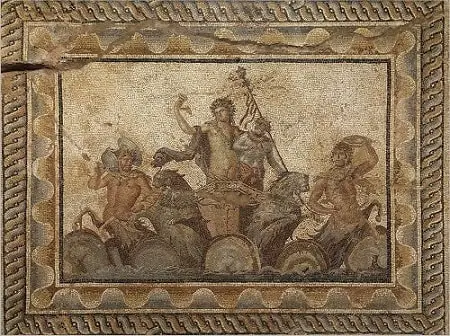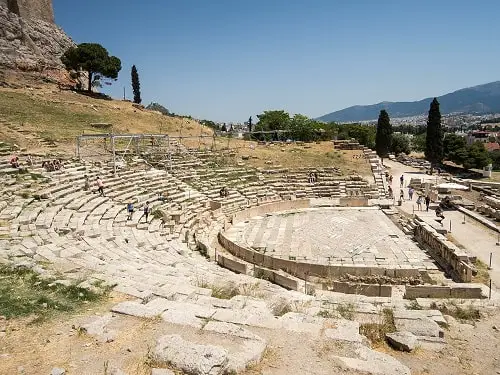The Dionysia was a grand celebration in ancient Athens honoring the Ancient Greek deity Dionysus, the god of Wine. The main activities of which were artistic displays of tragedies and comedies.
It was the second most significant celebration after the Panathenaia. The Dionysia was actually two separate festivals, the Rural Dionysia and the City Dionysia, held at different times of the year.
They were also an essential component of the Dionysian Mysteries and the most important theatrical event in 5th-century Athens.
Every spring (about March), playwrights competed to captivate the throngs of Athenian citizens.
Up to 16,000 Athenian citizens (excluding women, enslaved people, metoioi, and metics) would crowd into the amphitheater to see the latest plays by Aeschylus, Euripides, Sophocles, and Aristophanes.
Even if the plays changed, this feast of regeneration would not.
A massive procession, or Pompe, would bring the sacred statue of Dionysus from beyond the city limits to the Dionysus theater, which was located near the Acropolis.
In celebration of Dionysus, choruses would sing Dithyrambs, and gigantic phalloi would be paraded along the cortege path. All of this would be complemented by copious amounts of booze and general debauchery.
The day would commence with another parade after a night of rest. The war orphans would march down the boulevard in remembrance of their fathers who had given their lives for the sake of the city.
They would then have front-row seats in the theater. This parade would be preceded by three tragic pieces by a single playwright, as well as a semi-comedic Satyr play.
The Satyr plays were designed to relieve “womanly feelings” induced by tragedies and restore the audience’s “maleness” through bawdy jokes and even more alcohol.
What was the significance of the Dionysia?
Content
The wine festival was once Dionysia’s center point. Dionysia is an excellent and lavish festival held to honor the wine god Dionysus. It was celebrated in ancient Athens in honor of the God Dionysus.
This was regarded as the second most important and famous celebration, the first being the Panathenaia.
Why was the Dionysus festival important to the Athenians?
Not only did Dionysus grant Athenians the gift of wine to alleviate their pain, but he also granted them freedom from societal limitations.
The celebration of Dionysus’ status as the deity of the vine and winemaking was a feature shared by many of these Dionysus celebrations.
How far does the Dionysus festival last?
The competition lasted three days, one for each of the playwrights. Each playwright performed all three tragedies as well as the Satyr play in a single day.
Though Greek performances were shorter than modern plays, spectators would spend much of the day in the theater. Following the three days of presentations, popular voting would decide the winner.
Dionysia in the Countryside (Rural Dionysia)

The Dionysia was presumably a rural event in Eleuthera, Attica, honoring vine cultivation. It was most likely an ancient event initially not related to Dionysus.
This “country Dionysia” was celebrated in winter during Poseidon’s month between December and January.
The Pompe, or parade, was the main event where phalloi were borne by phallophoroi.
Kanephoroi (young girls who would carry baskets), obeliaphoroi ( who would carry bread loaves ), skaphephoroi ( who would carry various tributes), hydriaphoroi ( – who would hold water jars), and askophoroi ( who would carry wine jars) also partake in the Pompe.
There were dance and singing contests following the Pompe procession and choruses. led by choregos, reciting dithyrambs.
Some celebrations featured dramatic acts, presumably of tragedy and comedy staged the previous year in the City of Dionysia. It was majorly done in larger cities like Piraeus and Eleusis.
Spectators were able to attend and enjoy the festivals’ numerous events of the same kind, as many Attican towns conducted their celebrations on separate days of the week.
Similarly, Athenian inhabitants also traveled beyond their cities in cases where they have not done a single event throughout the year.
This also permitted traveling troupes of performers to play in multiple towns during the festival’s run. In his comedy, The Acharnians, Aristophanes’s comic playwright mocked the Rural Dionysia.
Origins of the City Dionysia

Dionysia ta en Astei or the Great Dionysia, mostly known as the City of Dionysia was the festival’s urban component, likely created during Peisistratus’ reign around the 6th century BC.
The famous celebration was presumably held three months after the rural Dionysia, between the 10th and 16th of the lunar month Elaphebolion, to commemorate the ending of winter and the reaping of the crops of that year.
This was founded when a town, Eleuthera, around the boundary of Boeotia and Attica opted to become a part of Attica.
However, the Athenians at the beginning rejected when the people of Eleuthera carried a Dionysus statue to Athens.
This initial rejection angered Dionysus and he cursed the people of Athenians and they were affected by a plague. This plague mostly afflicted male genitalia and was taken back only after the Athenians adopted his cult.
Every year, a march of townspeople carrying phalloi was held to commemorate this. The urban celebration was a comparatively new concept.
The Proagon and the Pompe

The archon began preparing for their wine God, City Dionysia, immediately after he was appointed, by appointing two páredroi and ten epimeltai, to assist in the festival’s organization.
The festival began with the hosting of the Pomp. The crowd had the gathering of the public, Athenian representatives, and some foreigners with partial privileges of citizenship.
The crowd, hauling a wooden statue of the wine god and holding a bronze phalloi outstretched on poles, began their procession toward the Southern slope of Acropolis to the Theatre of God Dionysus.
The procession also had bulls that were to be slaughtered in the theatre. Likewise, various gifts and weaponry displaying Athens’ strength were also transported around the mid-5th century BC.
The most visible crowd marching was the chorgo- the chorus leaders, leading their choruses, clothed in lavish and extravagant clothes.
The Athenians were then feasted with the sacrifice of the bulls that were brought along after the extravagant show displayed by the chorgo.
With the completion of the first, the second march known as kmos would begin with drunken merrymaking marching all across the streets.
The playwrights would then declare their play titles that were to be presented the following day. The presented play was judged by a panel of judges chosen randomly in the process known as proagon or the pre-contest.
The same process was used to honor citizens and mostly the foreigners who were noted for helping the city of Athens over the year.
Similarly, an event was also held to honor the fathers losing their lives during the Peloponnesian War. The orphan children of these fathers were made to parade in the Odeon.
The proagn might also be adopted for other announcements such as the death of some playwright or metics.
Theatrical Performances

The Theatre of Dionysus, after the Pompe, was sanctified by sacrificing a bull.
In 534 BC, the first rendition amongst numerous tragedies at the Dionysia was presented by actor Thespis. He was rewarded with Dionysia’s emblem which was a goat.
Despite the daily dispute amongst the researchers regarding the selection of the performance for that day, a total of 5 days during the event were reserved for the performance.
Out of 5 days, 3 days were assigned for the plays with a tragic theme, with each playwright presenting his composition of 3 tragic and 1 satyr play. The plays were enjoyed by all with reserved front rows for the judges, archons, and the epimeletai.
Amongst many, the most famous ones to be played at the Dionysus Theatre included the creation by Sophocles, Euripides, and Aeschylus.
Until 487/6 BC, the other two days of the celebration were most likely allocated to dithyrambic contests.
Each of the five comedy playwrights performed every day. However, there was an exception during the War of Peloponnesian when a total of 3 plays were only presented.
Until 449 BC, only theatrical works were recognized at the agon, but performers were also qualified for commendation after that date.
Conclusion
The celebratory days of Dionysia comprised three tragedies followed by a Satyr play. A day of five comic plays followed, providing Athenians a much-needed emotional break.
After the day of the comedy presentation, one day was set aside for recovery from the previous five days of inebriation and drunkenness.
Finally, the crowd would choose a winner on the seventh day (Aeschylus was a favorite, but Sophocles and Euripides also had their moments), and the festival came to an end.
So, how do masks fit into the overall picture of the festival? The festival supplies the mask with a much-needed social, physical, and religious context for its position as a mediator in Greek tragedy.
As such, Dionysia was the most prominent arts festival in the ancient Greek world. People from all around Greece attended the six-day Spring event in Athens, which included theater, music, dance, and community.
The festival also presented itself as a venue for gathering the Athenian legislative body.
As part of the meeting, Athenian inhabitants reviewed the festival and the performances and began arranging the event for the following year.
